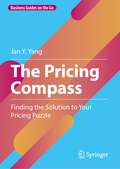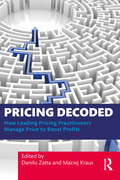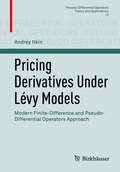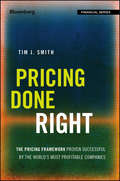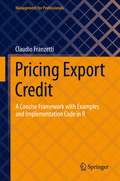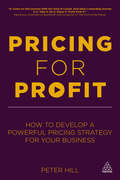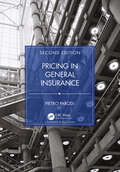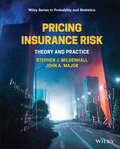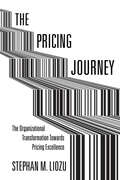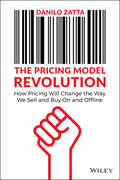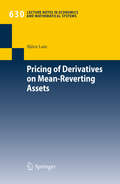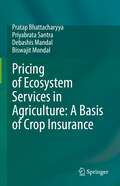- Table View
- List View
Pricing Carbon Emissions: Economic Reality and Utopia (Routledge Explorations in Environmental Economics)
by Aviel VerbruggenPricing Carbon Emissions provides an economic critique on the utopian idea of a uniform carbon price for addressing rising carbon emissions, exposing the flaws in the economic propositions with a key focus on the EU’s Emissions Trading System (ETS). After an Executive Summary of the contents, the chapters build up understanding of orthodox economics’ role in protecting the neoliberal paradigm. A salient case, the ETS is successful in shielding the Business-as-Usual activities of the EU’s industry, however this book argues that the system fails in creating innovation for decarbonizing production technologies. A subsequent political economy analysis by the author points to the discursive power of giant fossil fuel and electricity companies keeping up a façade of Cap-and-Trade utopia and hiding the reality of free permit donations and administrative price control, concealing financial bills mostly paid by household electricity customers. The twilights between reality and utopia in the EU’s ETS are exposed, concluding an immediate end of the system is necessary for effective and just climate policy. The work argues that the proposition of shifting to a global uniform carbon tax is equally utopian. In practice, a uniform price applied on heterogeneous cases is not a source of benefits but one of ad-hoc adjustments, exceptions, and exemptions. Carbon pricing does not induce innovation, however assumed by the economic models used by IPCC for advising global climate policy. Thus, it is persuasively demonstrated by the author that these schemes are doomed to failure and room and resources need to be created for more effective and just climate politics. The book’s conclusion is based on economic arguments, complementing the critique of political scientists. This book is written for a broad audience interested in climate policy eager to understand why decarbonizing progress is slow as it is. It marks a significant addition to the literature on climate politics, carbon pricing and the political economy of the environment more broadly. The Open Access version of this book, available at www.taylorfrancis.com, has been made available under a Creative Commons Attribution-Non Commercial-No Derivatives 4.0 license.
Pricing Carbon in Australia: Contestation, the State and Market Failure (Routledge Advances in Climate Change Research)
by Rebecca PearseIn the mid-2000s it seemed that the global carbon market would take off and spark the worldwide transition to a profitable low carbon economy. A decade on, the experiment in carbon trading is failing. Carbon market schemes have been plagued by problems and resistance to carbon pricing has come from the political Left and Right. In the Australian case, a national emissions trading scheme (ETS) was dismantled after a long, bitter public debate. The replacement ‘Direct Action Plan’ is also in disrepute. Pricing Carbon in Australia examines the rise and fall of the ETS in Australia between 2007 and 2015, exploring the underlying contradictions of marketised climate policy in detail. Through this and other international examples, the book offers a critique of the political economy of marketised climate policy, exploring why the hopes for global carbon trading have been dashed. The Australian case is interpreted in light of a broader legitimation crisis as state strategies for (temporarily) displacing the climate crisis continue to fail. Importantly, in the wake of carbon market failure, alternative agendas for state action are emerging as campaigns for the retrenchment of fossil fuel assets and for just renewable energy transition continue transforming climate politics and policy as we know it. This book is a valuable resource for practitioners and academics in the fields of environmental policy and politics and social movement studies.
The Pricing Compass: Finding the Solution to Your Pricing Puzzle (Business Guides on the Go)
by Jan Y. YangThis book provides business owners and practitioners with a comprehensive and pragmatic guide to pricing, which lays out the essential steps to professionalizing pricing from day one all the way to a more mature stage. It not only details the key activities leading to result-driven pricing strategies and execution but also addresses the most important pillars of good pricing governance. To do so, the book covers a broad range of pricing topics relevant at different stages of business evolution, e.g. determining the starting point of the pricing journey, identifying unique selling propositions, gauging willingness to pay (WTP), conducting effective customer profiling, improving promotions, and managing distribution from a pricing standpoint. The book fills a gap in the current pricing literature, which largely consists of descriptive and retrospective narratives cataloging past pricing strategies and tactics that never delve into the underlying rationale and methodologies. It provides readers with clear, actionable insights on how to price their own products and services.
Pricing Credit Products
by Robert L. PhillipsIn the wake of the 2008 financial crisis, it became apparent that pricing loans in a way that is profitable for lenders and sensitive to risk is anything but simple. Increasingly, lenders are following the lead of other retailers by segmenting their market and more precisely targeting customers. To do this successfully, lenders must engage analytic approaches, such as machine learning and optimization, in setting prices for each segment. Robert L. Phillips worked with major banks and financial services companies for more than a decade to help them improve their pricing capabilities. This book draws on his experience, as well as the latest academic research, to demonstrate how lenders can apply the proven techniques of price optimization to responsibly improve the profitability of their loans. It is a go-to resource for academics and professionals alike, particularly lenders who are looking for ways to do better business in an increasingly competitive (and regulated) market.
Pricing Decoded: How Leading Pricing Practitioners Manage Price to Boost Profits
by Danilo Zatta Maciej KrausPricing is a key priority of every company globally, as both customers and businesses grapple with ever more challenging economic conditions. Pricing Decoded is an authoritative but easy-to-read guide to support the transition to robust pricing to drive profitability.Renowned pricing experts Danilo Zatta and Maciej Kraus show organizations how to boost profitability and build a competitive advantage, transforming the way to set and manage prices. Case studies from the world’s leading pricing practitioners in both B2C and B2B organizations, such as Alcatel-Lucent, Asashi, Google, BP-Castrol, Unilever, Microsoft, Borealis, Hilton, Nike, MediaWorld, Philips Healthcare, Schneider Electric, DHL, Zalando, Zuora, Workday, Assa Abbloy, and Coor, are presented throughout. This book makes smart and innovative pricing more accessible and understandable for all. It provides a strong foundation in the concepts as well as the application in business, empowering you to judge monetization opportunities in a more effective way and ultimately make better decisions.The book is relevant to C-levels, managers, entrepreneurs, investors, as well as sales, marketing, and pricing managers, who want to learn more about topline potentials and monetization through pricing and achieve sustainable growth.
Pricing Derivatives Under Lévy Models
by Andrey ItkinThis monograph presents a novel numerical approach to solving partial integro-differential equations arising in asset pricing models with jumps, which greatly exceeds the efficiency of existing approaches. The method, based on pseudo-differential operators and several original contributions to the theory of finite-difference schemes, is new as applied to the L#65533;vy processes in finance, and is herein presented for the first time in a single volume. The results within, developed in a series of research papers, are collected and arranged together with the necessary background material from L#65533;vy processes, the modern theory of finite-difference schemes, the theory of M-matrices and EM-matrices, etc. , thus forming a self-contained work that gives the reader a smooth introduction to the subject. For readers with no knowledge of finance, a short explanation of the main financial terms and notions used in the book is given in the glossary. The latter part of the book demonstrates the efficacy of the method by solving some typical problems encountered in computational finance, including structural default models with jumps, and local stochastic volatility models with stochastic interest rates and jumps. The author also adds extra complexity to the traditional statements of these problems by taking into account jumps in each stochastic component while all jumps are fully correlated, and shows how this setting can be efficiently addressed within the framework of the new method. Written for non-mathematicians, this book will appeal to financial engineers and analysts, econophysicists, and researchers in applied numerical analysis. It can also be used as an advance course on modern finite-difference methods or computational finance.
Pricing Done Right: The Pricing Framework Proven Successful by the World's Most Profitable Companies (Bloomberg Financial)
by Tim J. SmithPractical guidance and a fresh approach for more accurate value-based pricing Pricing Done Right provides a cutting-edge framework for value-based pricing and clear guidance on ideation, implementation, and execution. More action plan than primer, this book introduces a holistic strategy for ensuring on-target pricing by shifting the conversation from 'What is value-based pricing?' to 'How can we ensure that our pricing reflects our goals?' You'll learn to identify the decisions that must be managed, how to manage them, and who should make them, as illustrated by real-world case studies. The key success factor is to build a pricing organization within your organization; this reveals the relationships between pricing decisions, how they affect each other, and what the ultimate effects might be. With this deep-level insight, you are better able to decide where your organization needs to go. Pricing needs to be done right, and pricing decisions have to be made—but are you sure that you're leaving these decisions to the right people? Few managers are confident that their prices accurately reflect the cost and value of their product, and this uncertainty leaves money on the table. This book provides a practical template for better pricing strategies, methods, roles, and decisions, with a concrete roadmap through execution. Identify the right questions for pricing analyses Improve your pricing strategy and decision making process Understand roles, accountability, and value-based pricing Restructure perspectives to help pricing reflect your organization's goals The critical link between pricing and corporate strategy must be reflected in the decision making process. Pricing Done Right provides the blueprint for more accurate pricing, with expert guidance throughout the change process.
Pricing Export Credit: A Concise Framework with Examples and Implementation Code in R (Management for Professionals)
by Claudio FranzettiPricing of export credit is a challenge in the globalised world trade. Annual premia represent billions of euros or dollars and may determine competition. This book develops a rigorous new framework for pricing export credit products, e.g. buyer and supplier credit insurance and performance and working capital guarantees , based on well-known financial and actuarial theories. It introduces the products, the theories and the different data sources in order to apply the mathematical and financial ideas, e.g. discounting, risk-neutral valuation and Merton type defaults. It shows the differences of historical experience and implicit market pricing assumptions. The well-known OECD Arrangement is used as a benchmark for some part of the framework. Short code snippets in R are given in order to re-perform the results and have a basis to try own ideas. Many unprecedented exhibits give new insights into the subject matter. The book is targeted at practitioners and actuaries in the field with a good quantitative background.
Pricing for Profit: Multi-Part Pricing in the U.K. Credit Card Industry
by Peter J. CoughlanExamines the optimal pricing mechanism for credit cards.
Pricing for Profit
by Peter HillPrice is the most significant factor affecting the profitability of every business, profit centre or department. When the pressure is on to perform or grow, your instinct may be to discount, undercut your competitors, cut costs and promote through price. Yet these are often the last things you should do. Pricing for Profit is the most practical guide on pricing available. Using a firm, profit-focused framework developed running real projects for real businesses, this book shows you how by getting your pricing structures right you can make a huge difference to your bottom line. It gives business owners, managers and leaders simple, achievable pricing strategies that will deliver sustainable business growth. Can you afford to leave money on the table? If not, Pricing for Profit is the guide for you.
Pricing for Profit: The UK Credit Card Industry in the Late 1980s (A)
by Harborne W. Stuart Jr.Describes the United Kingdom credit card industry in the late 1980s, which was really three businesses: a cashless transaction business for merchants, a cashless transaction business for card holders, and a credit business for card holders. At the time of the case, overall profitability has dropped significantly. Added value analysis is used to identify that one of the three businesses is unlikely to remain profitable (cashless transactions for merchants). With this loss of profitability, the case then considers how to limit the losses in the one business that had already been unprofitable (cashless transactions for card holders). This latter step is a problem in interactive decision theory in which players have different perceptions about the game, and these perceptions, in turn, may be influenced by each other.
Pricing for Profit: The UK Credit Card Industry in the Late 1980s (B)
by Harborne W. Stuart Jr.Supplements the (A) case.
Pricing for Profit: The UK Credit Card Industry in the Late 1980s (C)
by Harborne W. Stuart Jr.Supplements the (A) case.
Pricing for Profit: The UK Credit Card Industry in the Late 1980s (D)
by Harborne W. Stuart Jr.Supplements the (A) case.
Pricing in Business (Routledge Library Editions: Industrial Economics #23)
by Douglas HagueThis book, first published in 1971, reports on the first detailed study of pricing decisions ever made in the UK. Based on case studies, it shows precisely how thirteen pricing decisions were taken. In doing so, it reveals the objectives pursued by these firms and how conflicts between these objectives were resolved. The assessments of the pricing decisions show the strengths and weaknesses of the procedures used by the firms, and the relative importance of economic and organizational elements in such decisions.
Pricing in General Insurance
by Pietro ParodiBased on the syllabus of the actuarial profession courses on general insurance pricing – with additional material inspired by the author’s own experience as a practitioner and lecturer – Pricing in General Insurance, Second Edition presents pricing as a formalised process that starts with collecting information about a particular policyholder or risk and ends with a commercially informed rate. The first edition of the book proved very popular among students and practitioners with its pragmatic approach, informal style, and wide-ranging selection of topics, including: Background and context for pricing Process of experience rating, ranging from traditional approaches (burning cost analysis) to more modern approaches (stochastic modelling) Exposure rating for both property and casualty products Specialised techniques for personal lines (e.g., GLMs), reinsurance, and specific products such as credit risk and weather derivatives General-purpose techniques such as credibility, multi-line pricing, and insurance optimisation The second edition is a substantial update on the first edition, including: New chapter on pricing models: their structure, development, calibration, and maintenance New chapter on rate change calculations and the pricing cycle Substantially enhanced treatment of exposure rating, increased limit factors, burning cost analysis Expanded treatment of triangle-free techniques for claim count development Improved treatment of premium building and capital allocation Expanded treatment of machine learning Enriched treatment of rating factor selection, and the inclusion of generalised additive models The book delivers a practical introduction to all aspects of general insurance pricing and is aimed at students of general insurance and actuarial science as well as practitioners in the field. It is complemented by online material, such as spreadsheets which implement the techniques described in the book, solutions to problems, a glossary, and other appendices – increasing the practical value of the book.
Pricing Information: How to Customize Both the Product and Its Price
by Carl Shapiro Hal R. VarianThis chapter examines the market structure of information goods and its implications for competitive pricing strategy. It focuses on several approaches to overcoming commoditization: personalizing products and prices, and establishing group rates.
Pricing Insurance Risk: Theory and Practice (Wiley Series in Probability and Statistics)
by Stephen J. Mildenhall John A. MajorPRICING INSURANCE RISK A comprehensive framework for measuring, valuing, and managing risk Pricing Insurance Risk: Theory and Practice delivers an accessible and authoritative account of how to determine the premium for a portfolio of non-hedgeable insurance risks and how to allocate it fairly to each portfolio component. The authors synthesize hundreds of academic research papers, bringing to light little-appreciated answers to fundamental questions about the relationships between insurance risk, capital, and premium. They lean on their industry experience throughout to connect the theory to real-world practice, such as assessing the performance of business units, evaluating risk transfer options, and optimizing portfolio mix. Readers will discover: Definitions, classifications, and specifications of risk An in-depth treatment of classical risk measures and premium calculation principles Properties of risk measures and their visualization A logical framework for spectral and coherent risk measures How risk measures for capital and pricing are distinct but interact Why the cost of capital, not capital itself, should be allocated The natural allocation method and how it unifies marginal and risk-adjusted probability approaches Applications to reserve risk, reinsurance, asset risk, franchise value, and portfolio optimization Perfect for actuaries working in the non-life or general insurance and reinsurance sectors, Pricing Insurance Risk: Theory and Practice is also an indispensable resource for banking and finance professionals, as well as risk management professionals seeking insight into measuring the value of their efforts to mitigate, transfer, or bear nonsystematic risk.
Pricing It Right: Strategies, Applications, and Pitfalls
by Richard LueckePricing is one of the linchpins of marketing strategy and success. Early markets are reached by "prestige pricing" and "price skimming" to make the product appear valuable to the target segment. This chapter emphasizes that these strategies develop perceived customer value in the product, and only then should "cost-plus" pricing be introduced to make the product available to all financial sectors. By then, a firm should have gained market leadership with profits redirected toward developing another prestige-priced, hot, new sell, perpetuating top-line growth throughout the market.
The Pricing Journey: The Organizational Transformation Toward Pricing Excellence
by Stephan M. LiozuInnovations in pricing can be transformative, but to reach their potential companies must devote equal attention to technical and organizational capabilities. Most firms, however, only pay attention to the technical dimensions of pricing, which severely limits the success of their initiatives. To remedy this, The Pricing Journey provides an integrated guide to the organizational, social, and behavioral aspects of pricing—drawing on principles of socio-technical change. Based on extensive qualitative and quantitative research in an array of firms around the world, Stephan M. Liozu provides a practical roadmap for management teams that aim to reach a new level of pricing power. Liozu introduces the 5 C model of transformation, which relies on change, capabilities, champions, confidence, and center-led organizational design to create effective and lasting pricing strategies. Rooting his recommendations in research and practice, Liozu proposes specific capabilities to develop on the road to pricing excellence. This book prepares pricing and marketing professionals to be true strategic partners, while contributing the study of pricing transformation.
Pricing Lives: Guideposts for a Safer Society
by W. ViscusiHow society’s undervaluing of life puts all of us at risk—and the groundbreaking economic measure that can fix itLike it or not, sometimes we need to put a monetary value on people's lives. In the past, government agencies used the financial "cost of death" to monetize the mortality risks of regulatory policies, but this method vastly undervalued life. Pricing Lives tells the story of how the government came to adopt an altogether different approach--the value of a statistical life, or VSL—and persuasively shows how its more widespread use could create a safer and more equitable society for everyone.In the 1980s, W. Kip Viscusi used the method to demonstrate that the benefits of requiring businesses to label hazardous chemicals immensely outweighed the costs. VSL is the risk-reward trade-off that people make about their health when considering risky job choices. With it, Viscusi calculated how much more money workers would demand to take on hazardous jobs, boosting calculated benefits by an order of magnitude. His current estimate of the value of a statistical life is $10 million. In this book, Viscusi provides a comprehensive look at all aspects of economic and policy efforts to price lives, including controversial topics such as whether older people's lives are worth less and richer people's lives are worth more. He explains why corporations need to abandon the misguided cost-of-death approach, how the courts can profit from increased application of VSL in assessing liability and setting damages, and how other countries consistently undervalue risks to life.Pricing Lives proposes sensible economic guideposts to foster more protective policies and greater levels of safety in the United States and throughout the world.
The Pricing Model Revolution: How Pricing Will Change the Way We Sell and Buy On and Offline
by Danilo ZattaAn incisive and accessible blueprint to pricing your company’s products and services In The Pricing Model Revolution: How Pricing Will Change the Way We Sell and Buy On and Offline, world renowned pricing expert Danilo Zatta delivers an essential and engaging blueprint to building an enduring competitive advantage with insightful pricing models. In the book, you’ll learn to identify the best monetization approaches for your products and how to execute the one that makes the most sense for your business. From freemium to subscription, pay-per-use, and even neuropricing, the author discusses every available option and shows you how to choose. Although it's rigorous and evidence backed, The Pricing Model Revolution avoids an overly academic perspective in favour of providing you with concrete, practical guidance you can apply immediately to start generating more revenue. You’ll learn things like: How to make smart and innovative pricing a core component of your next product offering How to distinguish between every new, future-oriented monetization approach Which factors to consider when you’re choosing on a new pricing model for your most popular products An essential read for C-level executives, managers, entrepreneurs, and sales team leaders, The Pricing Model Revolution belongs on the bookshelves of every business leader seeking to learn more about one of the foundational topics driving top-line revenue and bottom-line profitability today.
Pricing Models of Volatility Products and Exotic Variance Derivatives (Chapman and Hall/CRC Financial Mathematics Series)
by Yue Kuen Kwok Wendong ZhengPricing Models of Volatility Products and Exotic Variance Derivatives summarizes most of the recent research results in pricing models of derivatives on discrete realized variance and VIX. The book begins with the presentation of volatility trading and uses of variance derivatives. It then moves on to discuss the robust replication strategy of variance swaps using portfolio of options, which is one of the major milestones in pricing theory of variance derivatives. The replication procedure provides the theoretical foundation of the construction of VIX. This book provides sound arguments for formulating the pricing models of variance derivatives and establishes formal proofs of various technical results. Illustrative numerical examples are included to show accuracy and effectiveness of analytic and approximation methods. Features Useful for practitioners and quants in the financial industry who need to make choices between various pricing models of variance derivatives Fabulous resource for researchers interested in pricing and hedging issues of variance derivatives and VIX products Can be used as a university textbook in a topic course on pricing variance derivatives
Pricing of Derivatives on Mean-Reverting Assets
by Björn LutzThe topic of this book is the development of pricing formulae for European style derivatives on assets with mean-reverting behavior, especially commodity derivatives. For this class of assets, convenience yield effects lead to mean-reversion under the risk-neutral measure. Mean-reversion in the log-price process is combined with other stochastic factors such as stochastic volatility, jumps in the underlying and the price process and a stochastic target level as well as with deterministic seasonality effects. Another focus is on numerical algorithms to calculate the Fourier integral as well as to integrate systems of ordinary differential equations.
Pricing of Ecosystem Services in Agriculture: A Basis of Crop Insurance
by Pratap Bhattacharyya Priyabrata Santra Debashis Mandal Biswajit MondalThe book deals with the pricing of ecosystem services provided by agriculture. All provisioning, regulating, supporting and cultural services are being covered in this title. Chapters in this contributed volume cover topics such as pricing of services from the soil, water, and nutrient management. Quantified monetary values of carbon sequestration and renewable energy applications in agriculture are covered with clear-cut methodologies. This book also links ecosystem service-based pricing with crop insurance. Improving the farmers’ livelihood is the central goal of the agricultural production system throughout the world. Under the climate change context, farms’ produce is now climate-vulnerable and heavily dependent on weather conditions. Moreover, we often neglect the contribution of several positive impacts of agricultural practices on ecosystems and natural resources. Therefore, there is a need to quantify and value these ecosystem services in agriculture. However, valuation and pricing the services in agriculture both tangible and intangible is a challenge. It is necessary to have clear-cut methodologies for pricing ecosystem services of agriculture in terms of net monetary benefits. The ecosystem service-based pricing could be a solid basis for calculating the insurance to farmers in case of occurrence of natural hazard and associated crop damage. This book is of interest to scholars, teachers, researchers, environmental scientists, watershed managers, capacity builders, and policymakers. The book also serves as effective reading material for undergraduate and graduate students of agriculture economics, ecology, agronomy, and environmental sciences. National and international agricultural scientists, policymakers will also find this to be useful.


